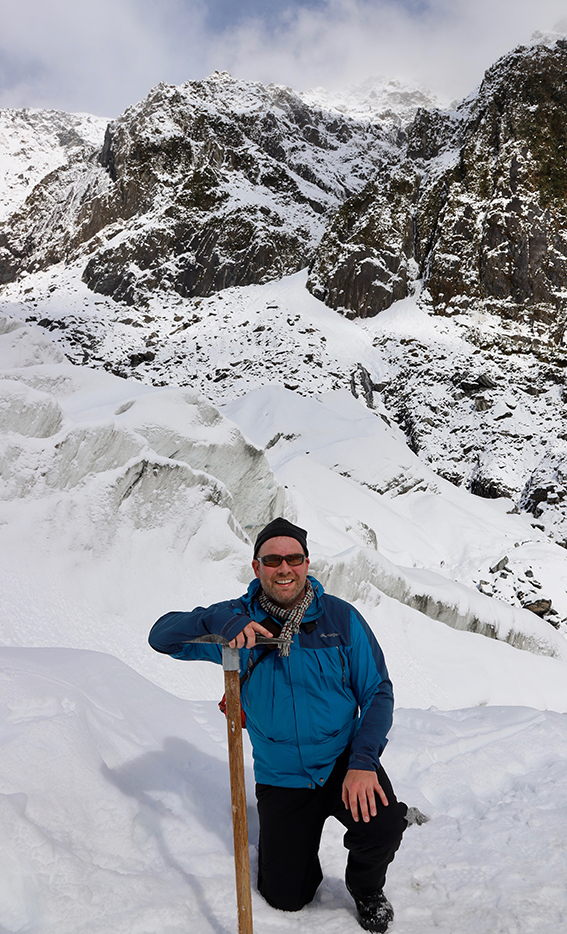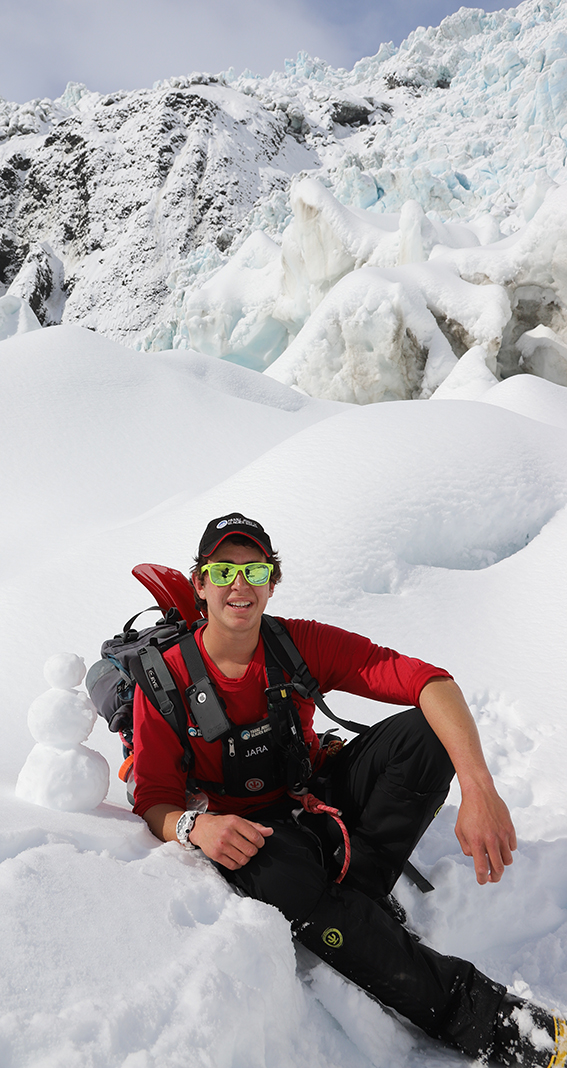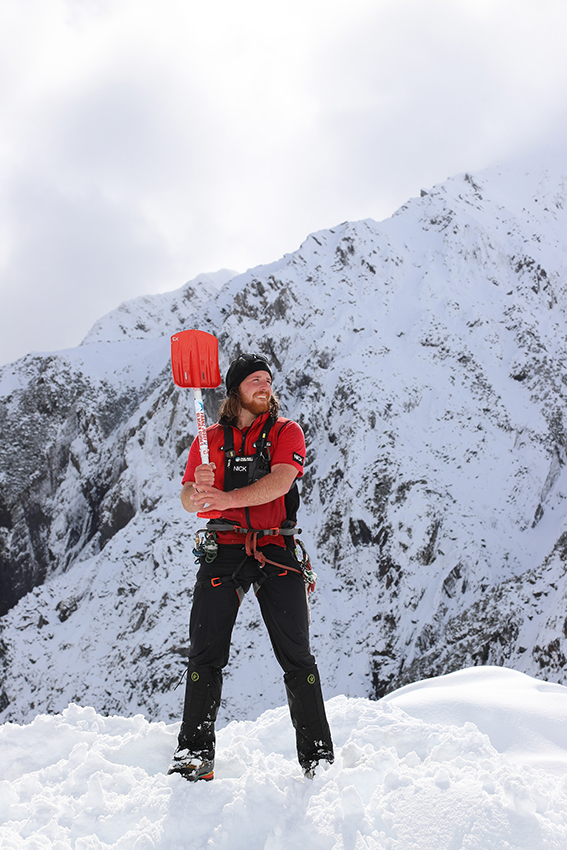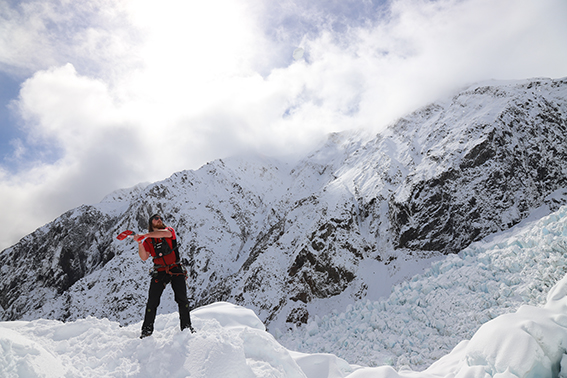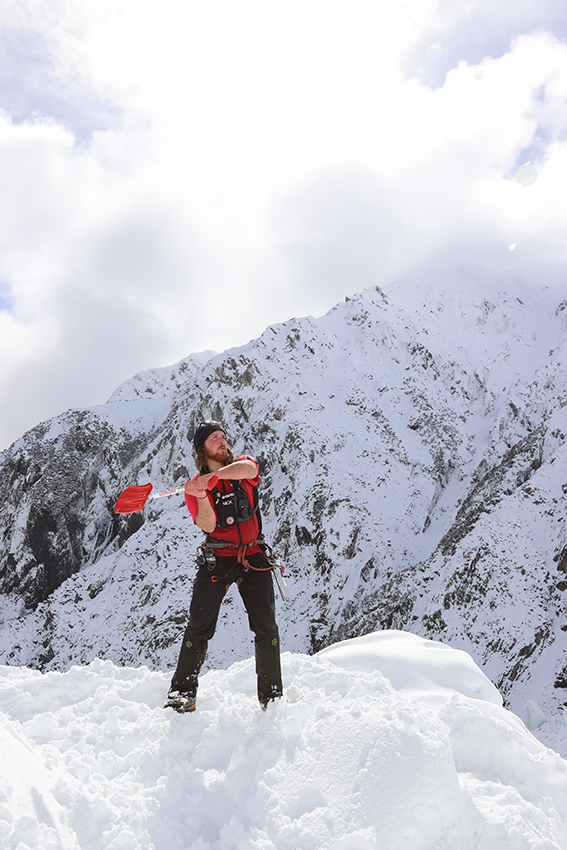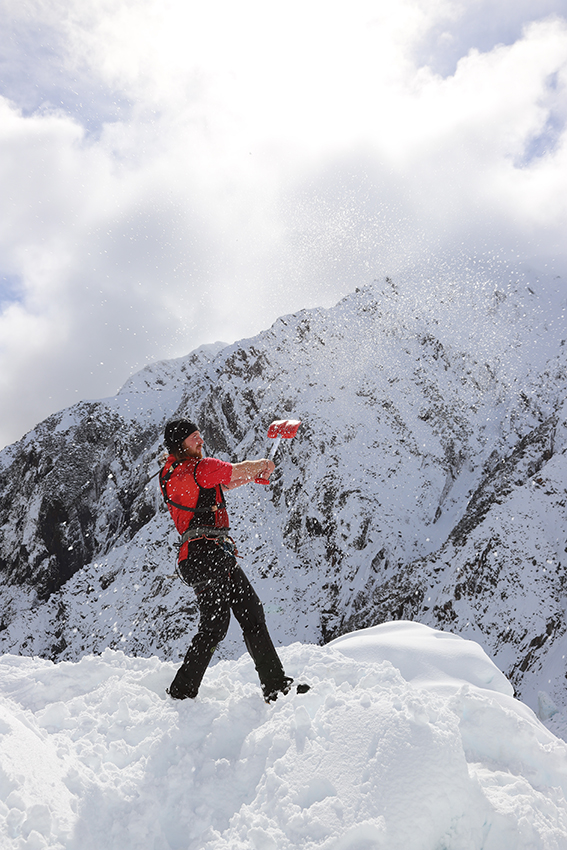Franz Josef Glacier
The last time I saw ice this inviting it was circling a highball of blue gin.
It's all about the 'blue' up on the Franz Josef Glacier: azure, cerulean, sapphire.
"Compression of air bubbles and light attenuation," our guide Jara explains as we muster at base camp.
I was never very good at science. Besides I'm too busy drinking in the glorious ice-scrapers soaring skyward all around me, and someone has just started throwing snowballs.
Game on: cricket-Franz-Josef-style with a snow shovel and I'm bowled a perfectly formed, frosted googly.
The weather is perfection: sunny, still and surprisingly warm.
Layers are shed and mittens stowed.
A foot of snow fell overnight, which has turned an incredible experience into pretty much a once in a lifetime.
This great icy arterial, which dissects the southern part of the Westland Tai Poutini National Park, can at times appear grimy and grey as it collects rocks, debris and dirt on its descent, but blanketed in 12 inches of snow it is crisp, white and radiant.
And it keeps getting better: Jara says we can ditch the crampons on account of the snow.
We sling them over our shoulder in small, standard-issue canvas bags - just in case we encounter any gnarly patches.
You hear "gnarly" and other surfy speak a lot up here on the ice.
Maybe it reflects the downtime pastimes of the guides, or perhaps it's because we're just 20 kilometres from the Tasman.
Thousands of years ago Franz actually dipped its toe in the sea.
It's unusual for a glacier to be so close to the coast.
Rare too, to find a temperate rainforest garnishing the foot of a glacial valley with lush foliage, speargrass and gigantic ferns.
Franz Josef Glacier strides across the landscape as if to pronounce this 'view belongs to me'.
And after seven thousand years, maybe it does.
But each year tens of thousands of visitors heli-hike onto the ice to share the experience and sneak a peek.
The last time I saw ice this inviting it was circling a highball of blue gin.
Walking on ice can be a punishing duty of concentration.
But the delicious and reassuring crunch of fresh, soft powdery flakes underfoot is far more forgiving, particularly when you tumble, which we do often during our three-hour trek.
The only way onto the ice is by an 'over-before-you-know-it' helicopter flight.
The choppers have been grounded for the past week.
And after today there's another week of bad weather forecast.
The glacier is every bit as magical as I imagined and a little bit more: snow-whipped peaks of white awesomeness.
And we're deposited right in the thick, landing on a small square of compacted snow, not much bigger than a bedspread.
Dust-off complete, the helicopter soars off into the cloudless sky to ferry another group.
There's a definite sense of urgency – a backlog of hikers eager to climb.
When will the weather turn again?
Since 2012, choppers have ferried day-trippers past the unstable terminal face.
Named Franz Josef after Austria's penultimate king-emperor, the world's steepest glacier snakes 12 kilometres up the valley to its source: a high-altitude basin.
Historically, in a constant cycle of advance and retreat, even the local church, St James, has a glacier viewing window behind the altar.
But you can't see Franz from there anymore - it's been in a steady retreat since 2008.
The glacier is roughly 20 percent shorter than it used to be, having receded about three kilometres since the 1800s when German geologist Julius von Haast named it after the Hapsburg royal.
"The white unsullied face of the ice was before us, broken up into a thousand turrets, needles and other fantastic forms," he wrote.
And so, I have high hopes for Franz.
And he has not disappointed.
Or is it a she?
Our guide shares the Maori legend: the glacier Kā Roimata o Hine Hukatere began as a stream of tears left by a young woman whose lover was killed by an avalanche.
As we gear up at the base camp, hikers all around me, giddy with excitement chatter in whispered awe.
Do you think we'll see blue ice someone asks?
Our guide Jara flashes a cheeky smile.
"Possibly".
Franz Josef Glacier strides across the landscape as if to pronounce this 'view belongs to me'.
We're a small but enthusiastic group of seven, from 17 to 70.
And we're just a little bit excited that we've made it this far.
Jara goes through a safety briefing before we grab our poles and crunch through the fresh snow and up the steps carved into the ice.
It's not long before out cheeks are pinched with a warm glow.
A couple of us have forgotten our water bottles but even those who haven't are devouring chunks of pristine snow for refreshment.
We are Spanish and Canadian and British. Franz calls to all corners of the globe and despite regular cancellations due to bad weather, people remain willing to travel thousands of kilometres with no guarantee they'll actually make it up.
And so it was with our group.
Mother Nature is fickle in this part of the world.
The night before the hike she seemed undecided whether to send rain, sleet, hail or snow – so she dumped it all on the small township of Franz Josef.
The tiny hamlet of about 400 can spike to several thousand as tourist numbers swell.
The morning of the hike, it was with more than a little trepidation I peeked through the curtains in my hotel room to gauge the weather.
Glorious.
I raced to the Franz Josef Glacier Guides headquarters on Cron Street before the weather changed its mind.
The tour operators advise a few days stay in the town in case of cancellations.
But I had one day and lady luck smiled and here we are on top of the glacier... on top of the world.
I look around the group.
Everyone is smiling. Everyone is grinning. Everyone is loving it.
Crunching on a foot or so of fresh snow is a delicious way to hike and we all sigh with relief that we don't need to use the crampons still slung about our necks.
The hike, for our group at least and perhaps on account of the snow, seems less of a gruelling climb and more of a gentle stroll.
Occasionally we pass through small ice caves and arches, or engage a rope to ease our descent, but it never feels dangerous or beyond the ability of anyone in the group.
The guide accommodates the comfort level for everyone.
Waiting for stragglers provides the perfect opportunity for selfies and more snow ball fights.
Jara warns us about rock and ice falls, and avalanches.
Despite the heads-up when we witness all three at various times throughout our hike – albeit at a safe distance - the thunderous rumble of cascading tonnage is both awesome and a little terrifying.
We pass crevasses and several times along the way we halt while Jara secures the path ahead by compressing snow or testing the route with his ice pick.
The radio at his hip periodically crackles commands from HQ and he keeps one eye fixed on the horizon where clouds begin to muster.
"It's going to turn to custard," Jara says.
But not now. Not for us.
Now, the return helicopter's rotors roar into life, whisking us high above the valley.
Now, we're leaving one of New Zealand's premier South Island experiences.
Now, the Franz Josef Glacier is about as good as it gets.
"I've never seen Franz so amazing," the pilot's voice crackles excitedly over the headphones as we gaze down on the snaking expanse of snow-covered ice.
My mind is buzzing: overwhelmed by what I've just experienced and the scale of the glacier, and the purity and rawness of the environment.
Camera lenses pressed to every window, snapping wildly at this otherworldly ribbon of crumpled snow and ice.
We are quiet on the return flight, deep in thought with an almost religious solemnity as we digest the last three hours.
As we walk back to HQ, nearly everyone in the group resists the temptation to hurl superlatives.
But when someone at the rear says, "that's the most amazing thing I've ever done," no one disagrees.
As we walk back to HQ, nearly everyone in the group resists the temptation to hurl superlatives.
But when someone at the rear says, "that's the most amazing thing I've ever done," no one disagrees.
The morning of the hike, it was with more than a little trepidation I peeked through the curtains in my hotel room to gauge the weather.
Glorious.
I raced to the Franz Josef Glacier Guides headquarters on Cron Street before the weather changed its mind.
The tour operators advise a few days stay in the town in case of cancellations.
But I had one day and lady luck smiled and here we are on top of the glacier... on top of the world.
I look around the group.
Everyone is smiling. Everyone is grinning. Everyone is loving it.
Crunching on a foot or so of fresh snow is a delicious way to hike and we all sigh with relief that we don't need to use the crampons still slung about our necks.
The hike, for our group at least and perhaps on account of the snow, seems less of a gruelling climb and more of a gentle stroll.
Occasionally we pass through small ice caves and arches, or engage a rope to ease our descent, but it never feels dangerous or beyond the ability of anyone in the group.
The guide accommodates the comfort level for everyone.
Waiting for stragglers provides the perfect opportunity for selfies and more snow ball fights.
Jara warns us about rock and ice falls, and avalanches.
Despite the heads-up when we witness all three at various times throughout our hike – albeit at a safe distance - the thunderous rumble of cascading tonnage is both awesome and a little terrifying.
We pass crevasses and several times along the way we halt while Jara secures the path ahead by compressing snow or testing the route with his ice pick.
Devouring chunks of pristine snow for refreshment.
The radio at his hip periodically crackles commands from HQ and he keeps one eye fixed on the horizon where clouds begin to muster.
"It's going to turn to custard," Jara says.
But not now. Not for us.
Now, the return helicopter's rotors roar into life, whisking us high above the valley.
Now, we're leaving one of New Zealand's premier South Island experiences.
Now, the Franz Josef Glacier is about as good as it gets.
"I've never seen Franz so amazing," the pilot's voice crackles excitedly over the headphones as we gaze down on the snaking expanse of snow-covered ice.
My mind is buzzing: overwhelmed by what I've just experienced and the scale of the glacier, and the purity and rawness of the environment.
Camera lenses pressed to every window, snapping wildly at this otherworldly ribbon of crumpled snow and ice.
We are quiet on the return flight, deep in thought with an almost religious solemnity as we digest the last three hours.
As we walk back to HQ, nearly everyone in the group resists the temptation to hurl superlatives.
But when someone at the rear says, "that's the most amazing thing I've ever done," no one disagrees.
For more go to www.franzjosefglacier.com
Franz Josef Glacier Tips
* Franz Josef is one of the fastest-moving glaciers in the world, up to 10 times faster than an average valley glacier with a rate of turnover up to 2.5 metres per day.
* Franz Josef Glacier Guides provide breathable rain jackets, waterproof over-trousers, socks and boots, crampons, a small waist bag, woollen hats and mittens.
* Bring sunglasses, sunscreen, a camera and a water bottle.
* Wear 2-4 warm upper body layers ideally woollen or polypro, not cotton.
* Children eight years and up are welcome but not usually until later in the day when hiking conditions tend to be easier.
* If your glacier heli-hike is cancelled the operators will either reschedule, arrange an alternative activity, or refund.
* Weight restrictions are strictly enforced (115kg).
* There are waivers to sign and kitting up takes time so make sure you arrive in plenty of time.
* No selfie sticks or some models of smartphone (the exploding type) on the aircraft.

